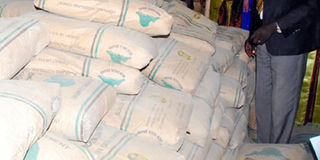Cement exports to DR Congo grow by 30%

Cement manufacturers have been seeking alternatives markets ever since Rwanda closed its borders to Ugandan goods in February 2019. PHOTO | FILE
Market for Uganda’s cement in DR Congo has grown by 27,000 tonnes in the last two years, according to Mr Israel Tinkasimire, the Hima Cement commercial director.
The increase, according to Hima Cement, which is one of Uganda’s largest cement exporters, represent a 30 per cent growth, which has created an alternative market for the commodity since Rwanda closed out much of Uganda’s exports in February 2019.
“The volumes have gone up, when the [Rwanda] border closed, we had been selling in the region of 90,000 tonnes. But it has since grown. The market in DR Congo has grown by about 30 per cent,” he said.
Government and a number of stakeholders, have been searching for alternative markets after Ugandan products have encountered blockades in some East African countries including Kenya, Tanzania and Rwanda.
Uganda had been exporting much of its cement to Rwanda but the export volumes almost collapsed to zero after Kigali closed its borders with Uganda in February 2019.
Hima Cement, just like other manufacturers, had turned to DR Congo for market and prospects have been building in the last two years.
Mr Tinkasimire said that while currently, movement of people to Rwanda is permitted, goods are still banned, which has forced the company to look to DR Congo, which is envisaged to offset the drop in demand occasioned by the Rwanda border impasse.
Government, through Ministry of Trade had earlier in 2019 told manufacturers to look for alternative markets, especially in South Sudan and DR Cong.
However, trading in DR Congo remains a challenging due to insecurity and poor infrastructure.
“In DR Congo, we have challenges with roads. Infrastructure is really a big challenge and there is an issue of insecurity, so we prefer to work with local partners on the ground to move the cement into the country, which is very constraining logistically,” Mr Tinkasimire said.
However, late last year government presented a request of more than Shs500b to Parliament seeking to work on the road network linking Uganda and DR Congo.
This has generated a lot of debate but government says this seeks to ease movement of exports to the country, especially in eastern DR Congo.
The border standoff between Uganda and Rwanda has cost Uganda millions of dollars in exports with volumes falling to just a few millions.
Exports outlook
According to data from Bank of Uganda, cement exports in the 2019/20 financial year fell to $59.9m compared to $61.5m in 2018/19.
Cement companies are also pushing for increased domestic consumption in an approach that is seeking to focus on inward consumption.
Demand for cement in the western region, for example, Mr Tinkasimire said, has grown by 60 per cent.




